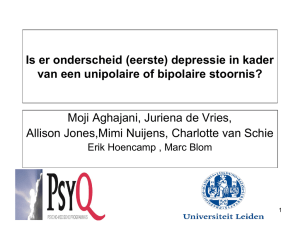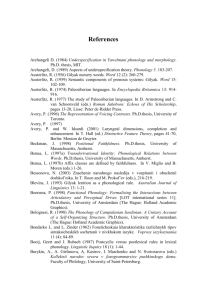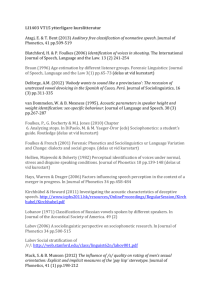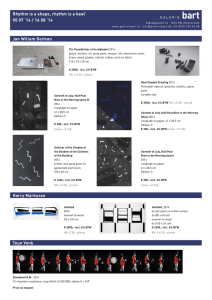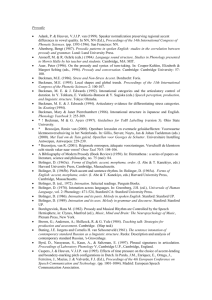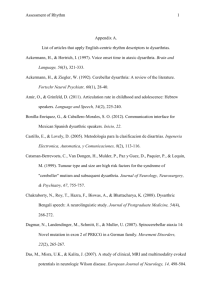Ritme - Rijksuniversiteit Groningen
advertisement
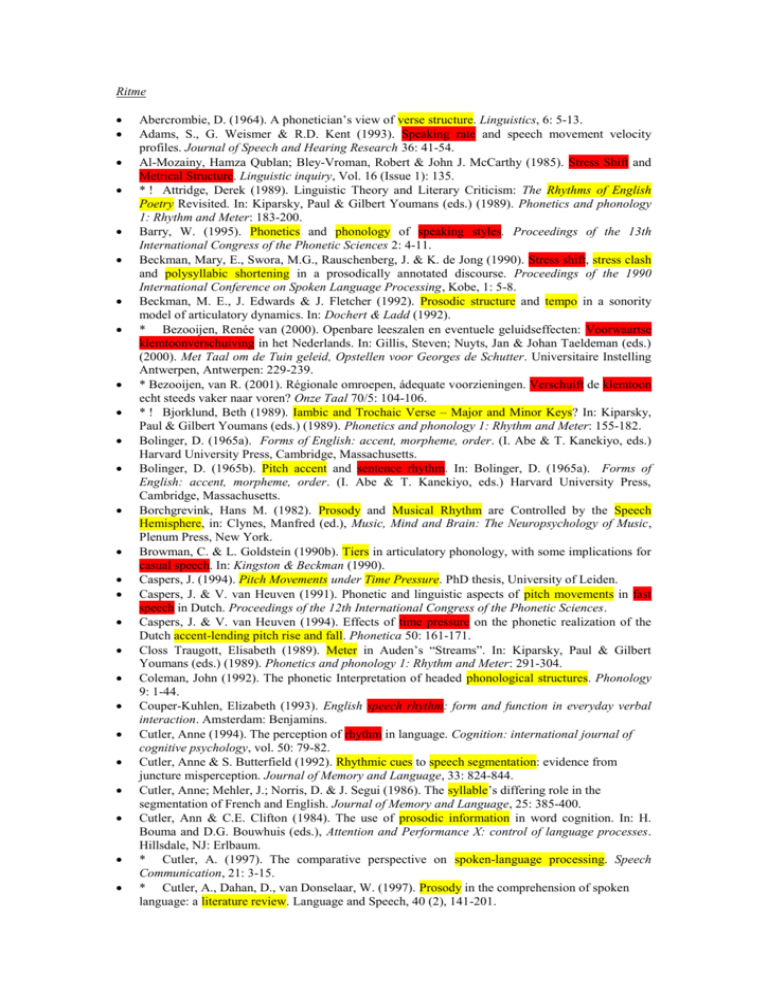
Ritme Abercrombie, D. (1964). A phonetician’s view of verse structure. Linguistics, 6: 5-13. Adams, S., G. Weismer & R.D. Kent (1993). Speaking rate and speech movement velocity profiles. Journal of Speech and Hearing Research 36: 41-54. Al-Mozainy, Hamza Qublan; Bley-Vroman, Robert & John J. McCarthy (1985). Stress Shift and Metrical Structure. Linguistic inquiry, Vol. 16 (Issue 1): 135. * ! Attridge, Derek (1989). Linguistic Theory and Literary Criticism: The Rhythms of English Poetry Revisited. In: Kiparsky, Paul & Gilbert Youmans (eds.) (1989). Phonetics and phonology 1: Rhythm and Meter: 183-200. Barry, W. (1995). Phonetics and phonology of speaking styles. Proceedings of the 13th International Congress of the Phonetic Sciences 2: 4-11. Beckman, Mary, E., Swora, M.G., Rauschenberg, J. & K. de Jong (1990). Stress shift, stress clash and polysyllabic shortening in a prosodically annotated discourse. Proceedings of the 1990 International Conference on Spoken Language Processing, Kobe, 1: 5-8. Beckman, M. E., J. Edwards & J. Fletcher (1992). Prosodic structure and tempo in a sonority model of articulatory dynamics. In: Dochert & Ladd (1992). * Bezooijen, Renée van (2000). Openbare leeszalen en eventuele geluidseffecten: Voorwaartse klemtoonverschuiving in het Nederlands. In: Gillis, Steven; Nuyts, Jan & Johan Taeldeman (eds.) (2000). Met Taal om de Tuin geleid, Opstellen voor Georges de Schutter. Universitaire Instelling Antwerpen, Antwerpen: 229-239. * Bezooijen, van R. (2001). Régionale omroepen, ádequate voorzieningen. Verschuift de klemtoon echt steeds vaker naar voren? Onze Taal 70/5: 104-106. * ! Bjorklund, Beth (1989). Iambic and Trochaic Verse – Major and Minor Keys? In: Kiparsky, Paul & Gilbert Youmans (eds.) (1989). Phonetics and phonology 1: Rhythm and Meter: 155-182. Bolinger, D. (1965a). Forms of English: accent, morpheme, order. (I. Abe & T. Kanekiyo, eds.) Harvard University Press, Cambridge, Massachusetts. Bolinger, D. (1965b). Pitch accent and sentence rhythm. In: Bolinger, D. (1965a). Forms of English: accent, morpheme, order. (I. Abe & T. Kanekiyo, eds.) Harvard University Press, Cambridge, Massachusetts. Borchgrevink, Hans M. (1982). Prosody and Musical Rhythm are Controlled by the Speech Hemisphere, in: Clynes, Manfred (ed.), Music, Mind and Brain: The Neuropsychology of Music, Plenum Press, New York. Browman, C. & L. Goldstein (1990b). Tiers in articulatory phonology, with some implications for casual speech. In: Kingston & Beckman (1990). Caspers, J. (1994). Pitch Movements under Time Pressure. PhD thesis, University of Leiden. Caspers, J. & V. van Heuven (1991). Phonetic and linguistic aspects of pitch movements in fast speech in Dutch. Proceedings of the 12th International Congress of the Phonetic Sciences. Caspers, J. & V. van Heuven (1994). Effects of time pressure on the phonetic realization of the Dutch accent-lending pitch rise and fall. Phonetica 50: 161-171. Closs Traugott, Elisabeth (1989). Meter in Auden’s “Streams”. In: Kiparsky, Paul & Gilbert Youmans (eds.) (1989). Phonetics and phonology 1: Rhythm and Meter: 291-304. Coleman, John (1992). The phonetic Interpretation of headed phonological structures. Phonology 9: 1-44. Couper-Kuhlen, Elizabeth (1993). English speech rhythm: form and function in everyday verbal interaction. Amsterdam: Benjamins. Cutler, Anne (1994). The perception of rhythm in language. Cognition: international journal of cognitive psychology, vol. 50: 79-82. Cutler, Anne & S. Butterfield (1992). Rhythmic cues to speech segmentation: evidence from juncture misperception. Journal of Memory and Language, 33: 824-844. Cutler, Anne; Mehler, J.; Norris, D. & J. Segui (1986). The syllable’s differing role in the segmentation of French and English. Journal of Memory and Language, 25: 385-400. Cutler, Ann & C.E. Clifton (1984). The use of prosodic information in word cognition. In: H. Bouma and D.G. Bouwhuis (eds.), Attention and Performance X: control of language processes. Hillsdale, NJ: Erlbaum. * Cutler, A. (1997). The comparative perspective on spoken-language processing. Speech Communication, 21: 3-15. * Cutler, A., Dahan, D., van Donselaar, W. (1997). Prosody in the comprehension of spoken language: a literature review. Language and Speech, 40 (2), 141-201. Darwin, C.J. & A. Donovan (1980). Perceptual studies of speech rhythm: isochrony and intonation. In: Simon, J.C. (ed., 1980). Proceedings of NATO ASI on Spoken Lnaguage Generation and Understanding. Dordrecht: Reidel. Das, Shyamal (2002). Some aspects of the prosodic phonology of Tripura Bangla and Tripura Bangla English. PhD Thesis, CIEFL Hyderabad. (on triple rhythm!) (see ROA) Dauer, R.M. (1983). Stress-timing and syllable-timing reanalyzed. Journal of Phonetics 11: 51-62. * i Desain, Peter & Luke Windsor (eds., 2000). Rhythm Perception and Production. Swets & Zeitlinger Publishers, Lisse, Abingdon, Exton (PA), Tokyo. Dirksen, A. (1992). Accenting and deaccenting: A declarative approach. Proceedings of the 15th International Conference on Computational Linguistics - Coling 92. Docherty, G. J. & D. R. Ladd (1992). Papers in Laboratory Phonology 2. Gesture, Segment, Prosody. Cambridge: CUP. Donovan, A. & C.J. Darwin (1979). The perceived rhythm of speech. In: Proceedings of the Ninth International Congress of Phonetic Sciences, Vol. 2. Copenhagen. Drake, C. & M-C. Botte (1993). Tempo sensitivity in auditory sequences: evidence for a multiplelook model. Perception and Psychophysics, 54 (3): 277-286. Erickson, Frederick (1992). They know all the lines: rhythmic organization and contextualization in a conversational listing routine. In: Auer, Peter & Aldo di Luzio (eds., 1992). The contextualization of language. Amsterdam: John Benjamins: 365-396. Flege, J. (1988). Effects of speaking rate on tongue position and velocity of movement in vowel production. Journal of the Acoustical Society of America 84: 901-916. Fougeron, C. & S-A. Jun (1995). Properties of French intonation at fast speech rate. Proceedings of the 13th International Congress of the Phonetic Sciences (3). Fougeron, C. & S-A. Jun (1998). Rate Effects on French intonation: Prosodic organisation and phonetic realization. Journal of Phonetics 26: 45-70. Gay, (1981). Mechanisms in the control of speech rate. Phonetica 38: 148-158. Gilbers, D. (1984). Ritmische variabiliteit en vocaalreductie. TABU 14, 41-66. * Gilbers, D. (1987). Ritmische Structuur. Glot 10, 271-292. * Gilbers, D. en W. Jansen (1996). Klemtoon en ritme in Optimality Theory, deel 1: hoofd-, neven-, samenstellings- en woordgroepsklemtoon in het Nederlands. TABU 26, Groningen. Goedemans, R., Hulst, H. van der & Visch, E. (Eds., 1996). Stress patterns of the world, part 1: background. (HIL Publications, 2). The Hague: Holland Academic Graphics. * Grabe, Esther & Paul Warren (1995). Stress shift: do speakers do it or do listeners hear it? In: Connell, Bruce & Amalia Arvaniti (eds.) (1995). Phonology and Phonetic Evidence. Papers in Laboratory Phonology IV. Grela, B. & J. Gandour (1999). Case Study - Stress shift in aphasia: A multiple case study. Aphasiology: an international, interdisciplinary journal, Vol. 13: 151-166. * Grover, Cynthia & Jacques Terken (1995). The role of stress and accent in the perception of rhythm. Proceedings of the 13th International Congress of the Phonetic Sciences, vol. 4: 356-359. * Gussenhoven, C. (1991). The English Rhythm Rule as an accent deletion rule. Phonology 8: 1-35. Halle, Morris & William Idsardi (1995). General Properties of Stress and Metrical Structure. In: Goldsmith, John A. (ed.) (1995). The Handbook of Phonological Theory, chapter 11: 403-443. Handel, S. (1989). Listening: an Introduction to the Perception of Auditory Events. Cambridge. * Hayes, Bruce (1984). The Phonology of Rhythm in English. Linguistic Inquiry, vol. 15: nr. 1, 33-74. Hayes, Bruce (1989). Compensatory Lengthening in moraic phonology. Linguistic Inquiry 20: 253-306. * i Hayes, Bruce (1989). The Prosodic Hierarchy in Meter. In: Kiparsky, Paul & Gilbert Youmans (eds.) (1989). Phonetics and phonology 1: Rhythm and Meter: 201-260. Hayes, Bruce (1995). Diagnosing Stress Patterns. In: Metrical Stress Theory: Principles and Case Studies. Chicago: University of Chicago Press: 5-23. Heuven, Vincent van (1991). Stress clash avoidance in Dutch: inversion of stress patterns in complex nouns? Proceedings of the XIIth International Congress of Phonetic Sciences, Aix-enProvence, 3: 226-229. Hirschberg, Julia (1995). Prosodic and Other Acoustic Cues to Speaking Style in Spontaneous and Read Speech. Proceedings of the 13th International Congress of the Phonetic Sciences 2: 36-43. Horne, M. (1990). Empirical evidence for a deletion formulation of the rhythm rule in English. Linguistics 28: 959-981. Horne, M. (1993). The phonetics and phonology of the rhythm rule in post-focal position: data from English. Phonum 2: 69-77. Hulst, H. van der (1984). Syllable Structure and Stress in Dutch. Doctoral thesis, Leiden University. Foris Publications, Dordrecht. Hulst, H. van der (1995). Metrical Phonology. Glot International, vol. 1: 3-6. Hulst, H. van der & N. Smith (eds.) (1985). Advances in Nonlinear Phonology, Linguistic Models 7, Foris Publications. Hyman, Larry (1985). A Theory of Phonological Weight. Dordrecht: Foris. Jacobs, Haike (1999). Constraining Constraints: NonFinality and the Typology of Footextrametricality. In Bezooijen, Renée & René Kager (eds.) Linguistics in the Netherlands 1999, John Benjamins Publishing Company, Amsterdam/Philadelphia: 111-120. Jacobs, Haike (2000). The revenge of the uneven trochee: Latin main stress, metrical constituency, stress-related phenomena and OT. In Lahiri, Aditi (ed.) Analogy, Levelling, Markedness, Mouton de Gruyter, Berlin, New York: 333-352. * Jansen, W. (1996?). Inherited Accents. Doctoraalscriptie Engelse Taal- en Letterkunde, Rijksuniversiteit Groningen. Jong, Kenneth J. de (2001). Rate-Induced Resyllabification Revisited. Language and Speech, 44 (2): 197-217. Kager, René (1989). A metrical Theory of Stress and Destressing in English and Dutch. Foris, Dordrecht. * Kager, René (1994). Ternary rhythm in alignment theory, Onderzoeksinstituut voor Taal en Spraak, Rijksuniversiteit Utrecht (Rutgers Optimality Archive -35). Kager, René (1995). The Metrical Theory of Word Stress. In: Goldsmith, John A. (ed.) (1995). The Handbook of Phonological Theory, chapter 10: 367-402. Kager, René (2001). Rhythmic Directionality by Positional Licensing. Fifth HIL Phonology Conference (HILP 5), University of Potsdam. (ROA 514). Kager, René & E.A.M. Visch (1988). Metrical constituency and rhythmic adjustment. Phonology 5 (1), 21-72. Keating, P. (ed.) (1994). Phonological Structure and Phonetic Form: Papers in Laboratory Phonology III. Cambridge: CUP. Kingston, J. & R. Diehl (1994). Phonetic Knowledge. Language 70: 419-454. Kingston, J. & M. E. Beckman (eds.) (1990). Papers in Laboratory Phonology I. Between the Grammar and Physics of Speech. Cambridge: CUP. * ! Kiparsky, Paul (1989). Sprung Rhythm. In: Kiparsky, Paul & Gilbert Youmans (eds.) (1989). Phonetics and phonology 1: Rhythm and Meter: 305-340. i Kiparsky, Paul & Gilbert Youmans (eds.) (1989). Phonetics and phonology 1: Rhythm and Meter. Klatt, D. (1976). Segmental Duration in English. Journal of the Acoustical Society of America 59 (5), 1208-1216. Kohler, K. J. (1983). Stress-timing and speech rate in German: a production model. In W. Barry & K. Kohler (eds.) Arbeitsberichte. Vol. 20. Kiel: Institut für Phonetik Universität Kiel. Kohler, K. J. (1995a). The phonetics and phonology of speaking styles. An overview. Proceedings of the 13th International Congress of the Phonetic Sciences (2) Kohler, K. J. (1995b). Articulatory reduction in different speaking styles. Proceedings of the 13th International Congress of the Phonetic Sciences (2): 12-19. Kooij, J.G. & M. van der Niet (1985). Stress, stress shift, and morphology: the case of Dutch -baar. In: Van der Hulst, H. & N. Smith (eds.) (1985), Advances in non-linear phonology, Foris Publ., 101-116. Kubozono, H (1989). The mora and syllable structure in Japanese: evidence from speech errors. Language and Speech, 25: 175-183. Lane, H.,& F. Grosjean (1973). Perception of reading rate by speakers and listeners. Journal of Experimental Psychology: 97: 141-147. * ! Lee, Christopher S.; McAngus Todd, Neil P.; Foster, Geraldine A. & Sevda Lomlu (2000). Preliminary investigations of French and English speech rhythm: are cross-linguistic differences in rhythmic organisation primary metrical in origin? In: Desain, Peter & Luke Windsor (eds., 2000a). Rhythm Perception and Production. Swets & Zeitlinger Publishers, Lisse, Abingdon, Exton (PA), Tokyo: 249-263. * Liberman, M. & A. Prince (1977). On Stress and Linguistic Rhythm. Linguistic Inquiry, vol. 8, nr. 2, 249-336. Lindblom, B. (1963). Spectrographic study of vowel reduction. Journal of the Acoustical Society of America 35: 1773-1781. Lindblom, B. (1990). Explaining phonetic variation: a sketch of the H&H theory. In W. Hardcastle A. Marchal (eds.) Speech Production and Speech Modelling. Dordrecht: Kluwer, 403-439. Martin, J. (1972). Rhythmic (Hierarchical) versus Serial Structure in Speech and Other Behavior. Psychological Review, lxxix: 487-509. * McCarthy, J. J. (1986). OCP Effects: Gemination and antigemination. Linguistic Inquiry 17: 207-263. * McCarthy, J..J. & A.S. Prince (1993). Generalized Alignment. Yearbook of Morphology: 79154. Mellander, Evan (2001). Conflict resolution in diphthongs: sonority and mora rhythm. HIL – Phonology 5, University of Potsdam, 1-14 (handout). Menert, L. (1994). Experiments on voice assimilation in Dutch: prosodic structures and tempo. PhD thesis, University of Utrecht. Mester, R. Armin (1994). The Quantitative Trochee in Latin. Natural Language and Linguistic Theory, vol. 12: 1-61. Miller, Joanne L. (1981). Some Effects of Speaking Rate on Phonetic Perception. Phonetica 38: 159-180. Moon, S.-J. & B. Lindblom, (1994). Interaction between duration, context, and speaking style in English stressed vowels. Journal of the Acoustical Society of America 96: 40-55. Moon, S.-J., Lindblom, B. & G. Lame (1995). Proceedings of the 13th International Congress of the Phonetic Sciences 2: 670-673. Morton, J.; Marcus, S. M.; & C.R. Frankish (1976). Perceptual centers (P-centers). Psychological Review, 83: 405-408. Müller, Katharina; Aschersleben, Gisa; Esser, K.H. & J. Müsseler (2000). Effects of elayed auditory feedback on speech: just a problem of displaced rhythm? In: Desain, Peter & Luke Windsor (eds., 2000a). Rhythm Perception and Production. Swets & Zeitlinger Publishers, Lisse, Abingdon, Exton (PA), Tokyo: 245-249. Nazzi, T.; Bertoncini, J. & J. Mehler (1998). Language discrimination by newborns: toward an understanding of the role of rhythm. Journal of Experimental Psychology: Human Perception and Performance, 24 (3): 756-766. Neijt, A. (1993). Stress shift in Dutch hexameters. Linguistics in the Netherlands, 1993. Neijt, A. (1999). The Structure of Rhythm. Linguistics in the Netherlands, 1999. Nespor, M. & I. Vogel (1989). On clashes and lapses. Phonology 6, 69-116. * ! Oehrle, R. (1989). Temporal structures in verse design. In: P. Kiparsky & G. Youmans (eds.), Rhythm and Meter. San Diego: Academic Press: 87-120. Otake, Takashi; Hatano, Giyoo; Cutler, Anne & Jacques Mehler (1993). Mora or Syllable? Speech Segmentation in Japanese. Journal of memory and language, vol. 32: 258 . Patel, A.D., Löfqvist, A., and Naito, W. (1999). The acoustics and kinematics of regularly-timed speech: A database and method for the study of the P-center problem. Proceedings of the 14th International Congress of Phonetic Sciences, San Francisco, 1999, Vol. 1: 405-408. (abstract) (paper - pdf) (database). Prince, A. (1983). Relating to the grid. Linguistic Inquiry 14, 19-100. Roach, P. (1982). On the discrimination between “stress-timed” and “syllable-timed” languages. In: Crystal, D. (Ed., 1982). Linguistic controversies. London: Edward Arnold. Sanderman, A.A. & René Collier (1996). Prosodic rules for the implementation of phrase boundaries in speech. Journal of the Acoustical Society of America 100: 3390-3397. Scott, D.R.; Isard, S.D. & B. de Boysson-Bardies (1985). Perceptual isochrony in English and French. Journal of Phonetics, 13: 155-162. * ! Selkirk, E.O. (1984). Phonology and Syntax: The Relation Between Sound and Structure. Cambridge, Mass.: MIT Press. Shattuck-Hufnagel, S. (1988). Acoustic phonetic correlates of stress shift. Journal of the Acoustical Society of America 84: S98. Shattuck-Hufnagel, S. (1991). Acoustic correlates of stress shift. Proceedings of the 12th International Congress of the Phonetic Sciences, Aix-en-Provence, 4: 266-269. Shattuck-Hufnagel, S. (1994). "stress shift' as early placement of pitch accents: a comment on Beckman and Edwards. In: Keating (1994). Shattuck-Hufnagel, S. (1995). The importance of phonological transcription in empirical approaches to "stress shift" versus "early accent": comments on Grabe and Warren, and Vogel, Bunnell and Hoskins. In: Connell, Bruce & Amalia Arvaniti (eds.) (1995). Phonology and Phonetic Evidence. Papers in Laboratory Phonology IV. Shattuck-Hufnagel, S., Ostendorf, M. & K. Ross (1992). Pitch accent placement within words. Proceedings of the IRCS Workshop on Prosody in Natural Speech, University of Pennsylvania, Philadelphia, 181-191. Shattuck-Hufnagel, S.; Ostendorf, M. & K. Ross (1994). Stress shift and early pitch accent placement in lexical items in American English. Journal of phonetics, Vol. 22 (Issue 4): 357-388. * ! Sluijter, Agaath (1995). Phonetic Correlates of Stress and Accent. PhD Thesis Rijksuniversiteit Leiden. Solé & J. Ohala (1991). Differentiating between phonetic and phonological processess. Proceedings of the 12th International Congress of the Phonetic Sciences (2): 110-113. Svensson, A.-M. (1997). Stress Shift in English Disyllabic Prefixed Noun-Verb Pairs. Moderna språk, Vol. 91: (Issue 2): 130-140. * ! Tarlinskaja, Marina (1989). General and Particular Aspects of Meter: Literatures, Epochs, Poets. In: Kiparsky, Paul & Gilbert Youmans (eds.) (1989). Phonetics and phonology 1: Rhythm and Meter: 121-154. Terken, J.M.B. (1985). Use and function of accentuation. Some experiments. Doctoral thesis, Leiden University. Todd, N.P.M., & S. Kohon (200?). Testing a sensory-motor theory of rhythm perception: human vs machine performance in tempo tracking. Todd, N.P.M.; Lee, C.S. & D.J. O’Boyle (200?). A sensory-motor theory of speech perception: implications for learning, representation, and recognition. In: Greenberg, S. & W. Ainsworth (eds., 200?). Listening to speech: an auditory perspective. Oxford: OUP. Todd, N.P.M.; D.J. O’Boyle & C.S. Lee (1999). A sensory-motor theory of rhythm, time perception and beat induction. Journal of New Music Research, 28(1): 1-24. * ! Visch, E.A.M. (1989). A Metrical Theory of Rhithmic Stress Phenomema. Proefschrift, Rijksuniversiteit Utrecht. Vogel, Irene, Bunnell, H. Timothy & Steven Hoskins (1995). In: Connell, Bruce & Amalia Arvaniti (eds.) (1995). Phonology and Phonetic Evidence. Papers in Laboratory Phonology IV. * ! Weismiller, Edward R. (1989). Triple Threats to Duple Rhythm. In: Kiparsky, Paul & Gilbert Youmans (eds.) (1989). Phonetics and phonology 1: Rhythm and Meter: 261-290. Yip, M. (1996). Feet, tonal reduction and speech rate at the word and phrase level in Chinese. Ms. (UCI, and Rutgers Optimality Archive). Youmans, Gilbert (1989a). Introduction: Rhythm and Meter. In: Kiparsky, Paul & Gilbert Youmans (eds.) (1989). Phonetics and phonology 1: Rhythm and Meter: 1-14. * ! Youmans, Gilbert (1989b). Milton’s Meter. In: Kiparsky, Paul & Gilbert Youmans (eds.) (1989). Phonetics and phonology 1: Rhythm and Meter: 341-380. Zubritskaya, Katya (1997). Mechanism of sound change in Optimality Theory. Language variation and change, Vol. 9, no. 1, 121. http://www.let.rug.nl/~schreudr/
